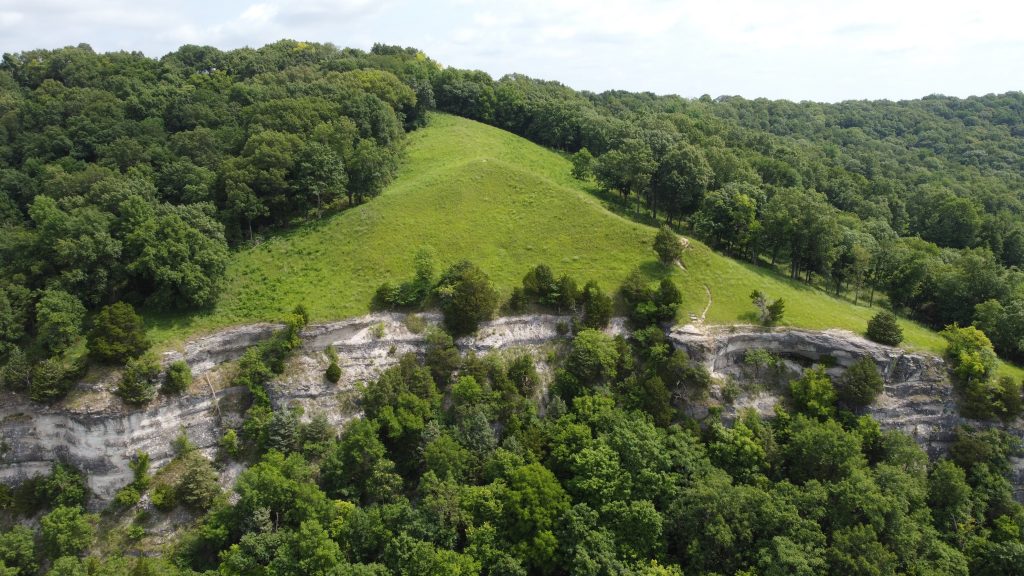Fults Hill Prairie NP Turns 50
by Phil Borsdorf, IDNR District Natural Heritage Biologist
Fults Hill Prairie Nature Preserve had a very special birthday in October 2020. This beloved natural inspiration celebrated 50 years as an Illinois Nature Preserve within the Illinois Nature Preserves System. Officially dedicated as such in 1970, it became Monroe County’s first Nature Preserve, and the 30th in the state of Illinois.

What does it mean to be a “dedicated” Nature Preserve within the Illinois Nature Preserves System? The Illinois Nature Preserves Commission (INPC) administers the Preserves System and its purpose remains to preserve and steward Illinois’ last high-quality examples of our natural heritage through legal protections. Such protection can be administered to both public and private lands. Nature Preserve status is the highest legal form of land protection in the state of Illinois.
Why was Fults Hill Prairie dedicated as a Nature Preserve? The site, aptly named, hosts the largest complex of high-quality hill prairies in the state of Illinois. Following the taxonomy of the Illinois Natural Areas Inventory, this type of natural community is classified as such: Class – Prairie, Subclass – Hill Prairie, Type – Loess Hill Prairie. Four types of hill prairies occur in Illinois: Dolomite, Glacial Drift, Gravel, and Loess. There are only about 600 acres of hill prairie remaining in the entire state!
What is loess? Loess is fine windblown sediment that, in this part of the state, was deposited by floodwaters/outwash associated with Illinois’ past glacial activity. Through time, prevailing winds picked up these sediments out of the dried floodplains and deposited them atop the limestone bluffs along a 30 mile stretch in Southwest Illinois known as the “Hill Prairie Corridor”.
Vegetation commonly associated with Illinois’ once vast prairies, took hold atop these steep, relatively isolated loess deposits. For many centuries, most of these prairies persisted primarily due to their physical location (difficult to access), edaphic conditions (steep, exposed, well-drained, and dry), and natural and anthropogenic disturbance (animal grazing/browsing, and human-initiated fires).
Although a good number of the hill prairies within the Hill Prairie Corridor were able to persist due to their natural tendencies and inaccessibility, over time, many have been lost. Today, more than ever, they are at risk of outright loss due to development or accelerated vegetative succession primarily in the form of native woody invasion. Ecologists and resource managers have recognized for some time that a lack of fire, air-flow/drying, climatic-change, and decreasing size has a compounding effect on the succession of these prairies to shrublands, and then to forest.
Why is it important to stave off this accelerated successional effect on hill prairies? Most succinctly, because of the loss of invaluable biodiversity, threatened and endangered species, and our natural heritage. Hill prairies host hundreds of flowering plants, numerous pollinating insects, imperiled herpetofauna, and, in this part of Illinois, locally-restricted species that only occur in this truly unique Natural Division known as the Ozarks (aka Illinois Ozarks). In terms of hill prairie loss, some of it can be attributed to what humans have directly caused, but, commonly, the loss has occurred indirectly due to often unnoticed change through time by unknowing landowners, and, a lack of resulting stewardship action.
Fults Hill Prairie Nature Preserve has been owned and managed by the Illinois Department of Natural Resources since the 1970s. While it has always been a priority site for IDNR and INPC and a recipient of management, in recent years, IDNR Division of Natural Heritage Staff have increased stewardship efforts to benefit the natural communities at the site. In the last three years, staff have increased the frequency and extent of prescribed burning on the site. Workdays conducted by IDNR, INPC, and partner staff have increased to remove woody invaders from the hill prairies and glades. Most notably and recently, IDNR has designed and funded large scale restoration projects through several professional contractors to remove invasive woody invaders from the hill prairie/glade/forested complexes, control exotic species, and install/expand firebreaks to increase the access and efficiency of IDNR prescribed burning and management efforts. The recent increase in stewardship efforts onsite are only a start, and persistent and expanded efforts are underway to continue the upward trajectory of the natural quality of the site. In future years, IDNR staff plan to further expand prescribed burning and invasive woody removal efforts in other forested areas of the site. Hill prairie management will be ongoing.
CLIFFTOP, a local nonprofit organization, is focused on preserving and protecting area blufflands.
A version of this article appeared in the September 22, 2021 edition of the Republic-Times.
©2021 all content rights reserved Clifftop NFP
Comments are currently closed.
